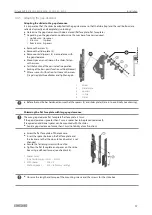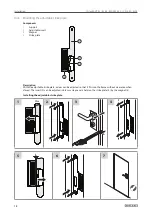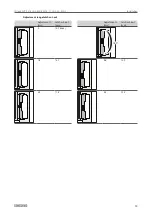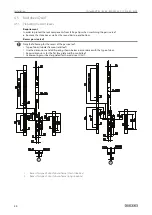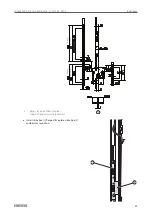
IQ lock AUT, EL / EL DL, EM / EM DL, C / C DL, M / M DL
7
Functions and properties
3
Functions and properties
3.1 Overview of functions
Function / property
IQ lock AUT * IQ lock EL/
EL DL
IQ lock EM/
EM DL
IQ lock C/
C DL
IQ lock M/
M DL
Panic function
Mechanical self-locking
Mechanical timeout function
–
–
Electrical timeout function
–
–
–
Approval for emergency exits
Approval for fire protection doors
Resistance Class (RC) 3
–
IQ lock EL
IQ lock EM
IQ lock C
IQ lock M
Secured by day with electric strike function
**
**
–
–
–
Motor-driven unlocking < 1 second (active
leaf)
–
–
–
Motor-driven unlocking < 1.8 seconds
(passive leaf)
–
–
–
–
Permanent unlocked
–
–
–
Outside handle, electronically engageable –
–
–
–
Automatic locking mechanism in the event
of a power failure
***
–
–
–
Automatic resetting of the release if door is
not opened
–
–
–
Input for fire alarm system (locking)
–
–
–
Unlocking by key
****
Operating voltage
24 V
12–24 V
12 V, 24 V,
48 V
–
–
Feedback contacts for lock states
–
Optional sabotage monitoring or cylinder
contact
–
Can be used on the left and right
–
Same installation dimensions for all IQ locks
*****
Backset 35, 40, 45, 55, 60, 65, 70, 80, 100
Distance 72, 74, 78, 92, 94
9 mm handle follower
à
continuous
–
à
divided
–
–
–
–
Approval in accordance with EN 1125
Approval in accordance with EN 179
Approval in accordance with EN 14846
–
–
–
–
Approval in accordance with EN 1634
VdS approval
–
IQ lock EL
IQ lock EM
IQ lock C
IQ lock M
Available
–
Not possible
*
Rod drive IQ AUT and IQ lock EL DL = IQ lock AUT
**
Active leaf for IQ lock DL
*** In conjunction with a GEZE battery pack
**** Unlocking via active leaf
***** IQ AUT 42 × 400 × 15.5 mm
3.2 Explanation of terms, functions and properties
Panic function
The lock can be unlocked at any time by pressing the door handle/panic bar in the direction of emergency exit.
Sliding door fitting
According to DIN EN 179 or 1125 the sliding door fittings must be tested together with the lock. Tested sliding
door fittings can be found in the certificates for consistency of performance (see chapter 7.1 and 7.2).

















